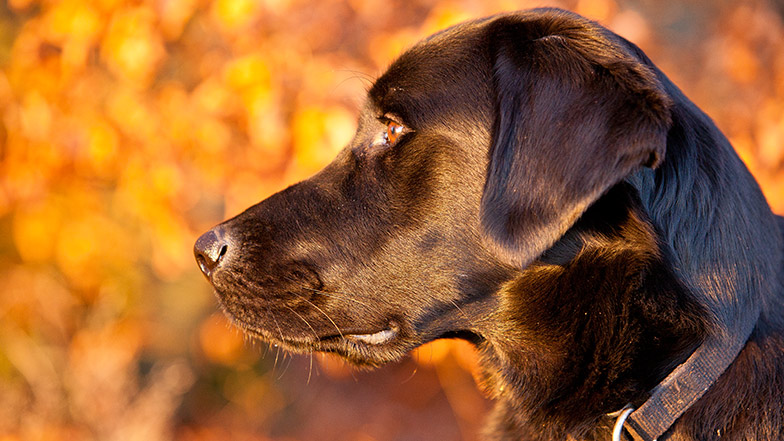As dog owners are drawn to woodlands to admire the kaleidoscopic leaves changing colour this Autumn, there are a few other things to look out for to keep canine companions safe.
From minor irritations to potentially fatal encounters, Dr Helen Whiteside, Head of Research at Guide Dogs shares her guidance on how to keep pets safe in the woods at this time of year.

Seasonal Canine Illness
Little is known about this illness, other than dogs afflicted with it often present symptoms such as vomiting diarrhoea and lethargy within one to three days of spending time in woodlands, usually between August and November.
While the exact cause of SCI remains unknown there are some precautions dog owners can take. Harvest mites are often found on infected dogs and it is thought there may be a link between the two, so it is advisable to use a dog-friendly insect repellent spray before going on a walk. It is also prudent to use a lead to keep dogs within close range where they can be observed, and ensure they are hydrated following walks as this may help if they do have SCI.
Conkers and acorns
Not only can spikey conker cases hurt sensitive paws if trod on, but if conkers are ingested can cause severe gastro-intestinal symptoms because they contain a chemical called aesculin which is toxic to dogs.
Acorns are also poisonous to dogs as they contain tannic acid, which can cause stomach upset and diarrhoea. In some cases, acorns can even cause serious kidney disease.
Owners should work on the ‘drop it’ command at home, and reward their dogs for giving up items they are holding. This will make it easier to retrieve dangerous items from dogs’ mouths while out on walks.
Mushrooms and mould
Dog owners should be cautious around piles of wet leaves. While they might present a fun opportunity play for many dogs, they often harbour mould and bacteria which can make dogs seriously ill, as well as toxic mushrooms.
Lungworm
Wet autumnal weather brings out slugs and snails, which are key spreaders of lungworm when eaten. This parasite that can be fatal to dogs if not treated and it is crucial they are taken to the vet if they start exhibiting symptoms such as breathing problems and coughing or show a reluctance to exercise. The most effective way to prevent dogs from contracting the parasite is to keep a could eye on them on walks and ensure they are treated regularly with a wormer which specifically covers lungworm.
Ticks
Damp, shady and dense vegetation and piles of dead leaves found in forests provide the perfect habitat for ticks. Owners should be vigilant to check their dogs for these small biting parasites following walks as they can transmit Lyme Disease which can be fatal for dogs and humans.
Ticks cannot fly or jump and instead latch onto animals and humans as they brush past plants, so heads and necks are the most common places for them to attach themselves to dogs. However, ticks can attach anywhere on the body so a full search is very important. If owners find a tick, it is important to remove it carefully with a tick hook instead of cutting, burning or pulling it off to ensure the head isn’t left attached to the dog’s body.
